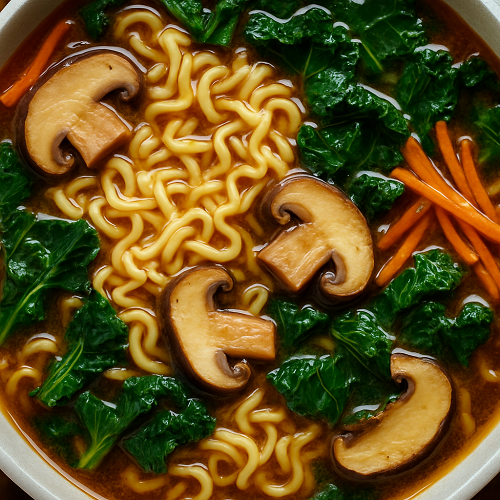Ultimate Guide to Homemade Ramen: Fast, Flavorful & Made for You


What Makes Great Ramen: Understanding the Essentials
To outrank, you need to go deeper than just a quick recipe. Let’s break down the pillars of excellent ramen:
| Component | Key Flavor/Texture Role | What to Look For |
|---|---|---|
| Broth / Soup Base | Heart of the bowl — richness, umami, fat, seasoning | Depth (bones, roasted or poached meats, aromatics, mushrooms, kombu, miso, etc.) |
| Tare (Seasoning Sauce) | Salt / flavor backbone — shoyu, miso, shio, tokuri | Balanced saltiness, acid, sweetness, and/or other flavor sharpeners |
| Noodles | Texture + mouthfeel — chew, spring, thickness | Fresh vs dried vs instant; alkaline content; cooking time |
| Aromatics & Seasonings | Complexity — garlic, ginger, scallion, chili, toasted sesame oil | Properly cooked, deglazed, added at correct stages |
| Toppings / Garnishes | Visual appeal, texture contrast, taste pops | Soft-boiled egg, chashu, nori, sprouts, mushrooms, bamboo shoots, etc. |
Fast Homemade Broth Recipes (15-minute to 1-hour versions)
Here are several good options depending on your time and dietary needs:
| Broth Style | Ingredients | Time | Flavor Profile |
|---|---|---|---|
| Quick Chicken Broth | Chicken bones (or wings), onion, garlic, ginger, scallions, a piece of kombu, dried shiitake | ~30-45 min | Clean, light, savory, good base for most toppings |
| Pork & Chicken Mix (Tonkotsu hybrid) | Pork bones (neck, trotters), chicken feet, garlic, onion, milk (optional), butter | ~1 hour (longer yields more richness) | Creamy, fatty, deeply satisfying |
| Vegan / Tofu & Mushroom | Dried shiitake / porcini, kombu, onion, garlic, miso, soy sauce | ~25-30 min | Umami-rich, earthy, satisfying even without meat |
| Miso / Shoyu / Shio Variants | Start with a blank broth, then add miso paste, soy sauce, or fine sea salt with a finishing oil | Dependent on base broth | Adds flavor depth, salt balance, regional character |
Tips to Maximize Flavor Fast:
- Roast bones or chicken parts ahead of time or buy roasted.
- Use kombu + dried mushrooms to punch umami without long simmer.
- Hot water vs cold water for extraction: start with cold for bones, hot for mushrooms/kombu.
- Use aromatics (onion, leek, garlic, ginger), either charred or blistered.
Noodles: Instant, Fresh, or DIY
- Instant Ramen Noodles (without flavor packet): Very fastest; cooks in ~2-4 min; texture is springy but softer.
- Fresh ramen noodles: Slight chew, excellent mouthfeel; cooks in ~1-2 min; best texture but cost/time trade-off.
- DIY alkaline noodles: Uses kansui or baking soda; more labor; great if you want full authenticity.
How to cook them: only in boiling water, rinse slightly (for fresh); don’t let them overcook; drain properly, or drop directly into broth off heat to finish.
Toppings & Flavor Boosters You Must Know
These are often what people find missing in the “quick ramen” versions. Without them, broth or noodles can seem bland.
- Proteins: Chashu (braised pork belly), shredded chicken (rotisserie or poached), slices of beef, tofu, pork sausage
- Egg styles: Ajitsuke tamago (marinated soft-boiled egg), soy braised eggs, slow-cooked eggs
- Vegetables: Baby bok choy, spinach, bean sprouts, corn, bamboo shoots (menma), leafy greens
- Mushrooms: Shiitake, enoki, wood ear — fresh or rehydrated
- Garnishes & Oils: Scallions, nori sheets, sesame seeds, toasted sesame oil, chili oil, yuzu peel, garlic oil, fried onions
- Flavor layers: Miso, tare (soy or shoyu), fermented beans, miso paste, fish sauce, shrimp stock
A Step-by-Step Fast Ramen Recipe (~30-45 Minutes)
Here’s a recipe that improves upon “quick ramen” by enhancing depth of broth and improving flavor balance — still fast, still flexible.
Ingredients (serves 2-3)
- 1 lb chicken thighs, skin on (or pork shoulder), or 2 cups firm tofu (for vegan)
- 5 cups good quality chicken or vegetable broth
- 2 cups water (adjust for richness)
- 1 piece kombu (≈4-5 in / 10-12 cm)
- 3 dried shiitake mushrooms
- 2 cloves garlic, smashed
- 1 thumb-size piece ginger, sliced
- 1 small onion, quartered
- 2 tbsp soy sauce (or tamari for gluten-free)
- 1 tbsp miso paste (optional)
- 2 packages fresh ramen noodles (or fresh noodles if available)
- Veggies: baby bok choy (halved), corn kernels, scallions, carrots
- Toppings: soft-boiled eggs, nori, sesame seeds, chili oil
Instructions
- Prep Aromatics and Stock: In a pot, heat a small bit of neutral oil. Add onion, garlic, ginger; sauté 1–2 minutes until fragrant. Add kombu & dried mushrooms.
- Add Broth & Water: Pour in broth and water; bring to gentle simmer. Remove kombu just before it boils to avoid bitterness.
- Cook Protein: Add chicken (skin side down) or tofu. Simmer 20 minutes, skimming foam. Remove chicken, shred; return to pot.
- Season: Whisk in soy sauce, miso (if using), adjust salt. Taste test — should be rich, balanced, slightly sweet/salty/umami.
- Cook Noodles Separately: Boil noodles as per package (fresh or “instant without seasoning”); drain well.
- Assemble Bowls: Noodles first, pour hot broth + protein over. Add veggies. Top with soft-boiled eggs, nori, scallions, sesame seeds, chili / garlic oil.
Common Issues & How to Fix Them
| Problem | Why It Happens | Quick Fixes |
|---|---|---|
| Bland Broth | Too much water; weak aromatics; weak or bland stock | Reduce water, increase aromatics, use dried mushrooms or kombu, add soy/miso |
| Greasy or Greasy Skin Fat | Using fatty meat or skin without skimming | Skim foam or fat; roast bones instead of boiling raw |
| Soggy / Overcooked Noodles | Over cooking; long sitting in broth | Cook separately; undercook slightly, then combine; serve immediately |
| Too Salty | Tare or soy added too early without enough liquid; flavor compounds concentrate | Add more water or broth; add acid (rice vinegar) to balance; reduce salt ingredients |
Variations from Around Japan and Asia
- Tonkotsu (Fukuoka style): Pork bone broth boiled until milky; thick noodles.
- Shoyu Ramen: Soy sauce tare; clearer broth, medium body.
- Shio Ramen: Light and salty; minimal toppings.
- Miso Ramen (Hokkaido): Rich miso base; hearty ingredients.
- Tsukemen: Dipping style — noodles served separately.
- Korean Ramen / Ramyeon Style: Spicy, kimchi, gochujang, fish cakes.
Meal Prep, Storage & Reheating Tips
- Broth stores well: fridge (3-4 days), freezer (2-3 months).
- Noodles: cook fresh. If you cook ahead, undercook by a minute, rinse, toss with oil, refrigerate; reheat in boiling water.
- Toppings (eggs, meat, veggies) can be prepped ahead and stored separately.
- Reheat broth to full boil before adding noodles + toppings to preserve texture and temperature.
FAQ
How do I make ajitsuke tamago (marinated soft-boiled egg)?
Boil 6-7 minutes, plunge into ice water, peel. Marinate in a mix of soy sauce, mirin (or a bit of sugar), and optional dashi or water; refrigerate for 4-12 hours.
Can I use instant ramen seasoning packets?
Yes — for convenience — but they’re usually very high in sodium and often one-dimensional. Best to discard or use only part and build your own tare + broth so flavor is richer.
What’s the difference between alkaline vs regular noodles?
Alkaline noodles (kansui) have higher pH — crisper and springier. Regular noodles are softer; fresh ramen usually uses alkaline water.
How do I reduce sodium?
Use low-sodium or homemade broth, reduce tare (soy/miso) quantity, add acid (vinegar or citrus), balance with sweetness (mirin or sugar), use more vegetables for bulk and flavor.
Ingredients Cheat Sheet & Tools Checklist
Cheat Sheet: Flavor Enhancers
- Kombu, dried shiitake, bonito flakes (for non-vegetarian)
- Roasting bones or veggies for richer caramelization
- Garlic oil or chili crisp, toasted sesame oil
- Acidic touches: rice vinegar, yuzu juice, lime
Tools That Help
- Heavy pot for broth (stock pot or Dutch oven)
- Strainer / fine sieve to remove solids
- Slotted spoon for skimming
- Sharp knife & proper cutting board for veggies
- Timer for eggs & noodles
In Summary
- The difference between “just ramen” and memorable ramen is layering flavor: good stock, proper seasoning (tare or miso/soy), crunchy and fresh toppings.
- Even if you’re short on time, you can still bring in combos of aromatics + umami boosters (mushrooms, kombu, miso) to lift a broth made mostly of water or basic stock.
- Customize boldly — what makes ramen great is how it becomes your bowl, with flavors, textures, spices chosen to your preference.



